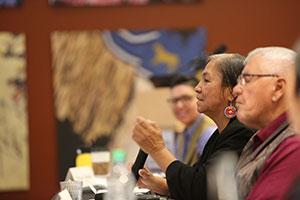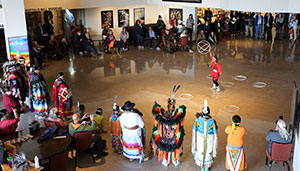
Contact Us
Institutional Communications
Bureau of Mines Building, Room 137
Laramie, WY 82071
Phone: (307) 766-2929
Email: cbaldwin@uwyo.edu
Agencies, Tribes, Landowners, Scholars, Students Come Together for Yellowstone at 150
Published June 20, 2022

Joyce Tatsey Spoonhunter speaks during a panel at the recent UW-hosted symposium commemorating
the 150th anniversary of Yellowstone National Park at the Buffalo Bill Center of the
West in Cody. (Patti Baldes Photo)
A symposium co-hosted last month by the University of Wyoming’s College of Law and Haub School of Environment and Natural Resources brought together more than 350 people, virtually and in person, to commemorate the 150th anniversary of Yellowstone, the nation’s first national park.
The two-day event at the Buffalo Bill Center of the West in Cody featured eight panels, five keynotes, tribal welcoming and closing ceremonies, and a formal dinner. The free public symposium traversed the past, present and future of Yellowstone National Park and the greater Yellowstone ecosystem.
“When you designate a piece of ground, things happen,” Gov. Mark Gordon told attendees during the dinner the first evening.
Participants engaged in onstage and offstage conversations celebrating the history of the park and also looked to it for lessons. There was a deepening understanding of the region’s past, a grappling with current and future issues, and a commitment to continue striving to do better.
Yellowstone is viewed not only as the jewel of Wyoming and a national treasure, but also as a singularly unique natural, historical, spiritual and cultural resource for the world. And it is homeland for more than 27 federally recognized tribes, many of which were represented by panelists, moderators, performers and attendees at the symposium.
Major themes included a commitment to transboundary collaboration; an extension of the decision-making table to better include tribal sovereigns and private landowners; excitement and caution about rising visitation; a desire to be proactive and forward-thinking; and gratitude for the forethought that helped to preserve the unique and dynamic place. The full agenda and video recordings of the panels and keynotes are available on the symposium website.
Here are some of the highlights:
-- Following opening remarks by UW President Ed Seidel, College of Law Dean Klint Alexander and Haub School Dean John Koprowski, sun dance chiefs from three Yellowstone-associated tribes presided over a tribal blessing and cedaring: Lee Juan Tyler (Shoshone-Bannock), Thomas Yellowtail (Crow) and James Trosper (Eastern Shoshone), who also is director of UW’s High Plains American Indian Research Institute and a symposium steering committee member. Mary Jane Goggles, a tribal elder and Mountain Shoshone descendant, offered the blessing, accompanied by a land acknowledgement from Shoshone-Bannock tribal member and attorney Jeanette Wolfley, as well as a welcome by Shoshone-Bannock tribal member and Mountain Shoshone descendant Randy’L Teton. Additionally, a dance performance by the Eagle Spirit Tribal Dancers brought the symposium to an end the following day.
-- The first panel affirmed that what is now Yellowstone National Park has been Native American homeland for millennia. Moderated by incoming UW law faculty member Autumn Bernhardt (Lakota), the panel explored the history of tribal connections to Yellowstone with panelists William C’Hair (Northern Arapaho); Hunter Old Elk (Crow and Yakama); Joyce Tatsey Spoonhunter (Blackfeet); Tyler; John Washakie (Eastern Shoshone); and Wolfley.
Panelists described Yellowstone variously as a creation area, healing place, pharmacy, refrigerator, nucleus and, perhaps most fundamentally, home. In addition to being able to access the park to gather medicines, they described education and interpretation as top priorities for the future.
“Thank you for taking care of our land, Yellowstone Park … and United States government,” Spoonhunter said. “You did a good job, but now you need to tell the whole story.”
-- Robert Keiter, a University of Utah law professor and author of “To Conserve Unimpaired: The Evolution of the National Park Idea,” delivered a keynote presentation tracing three “eras” of national parks and pointed toward a potential fourth era focused on large landscape conservation. In the case of Yellowstone, that means conservation of the greater Yellowstone ecosystem.
-- A panel of artists, curators, writers and communication professionals shared the importance of creative expression in sculpting public engagement with Yellowstone. From Thomas Moran’s “Grand Canyon of the Yellowstone” to modern-day social media posts, written and visual communication shapes the way people understand and interact with the park.
-- Another panel discussed the need for collaboration and coordination among the greater Yellowstone region’s varied federal, state, tribal and private land managers. Participants specifically discussed the need for tribal engagement, including recognition of traditional ecological knowledge and Indigenous spirituality. Wes Martel (Eastern Shoshone), a member of the Wind River Water Resources Control Board and the Wind River senior conservation associate at the Greater Yellowstone Coalition, noted that tribes have a proven track record of effective conservation and, in the case of the Wind River Indian Reservation, of managing landscapes as large as Yellowstone. Another key focus of the panel was working with private landowners, with an emphasis on education and the need to create economic signals for the value of conservation.
-- In addition to the governor’s address at the evening dinner, a welcome to Cody was provided by former U.S. Sen. Alan Simpson and Pete Simpson. A presentation of art from the Whitney Western Art Museum by Karen McWhorter, the Collier-Reed Director of Curatorial, Education and Museum Services at the Buffalo Bill Center of the West, and a musical performance by UW law student Jessie Salas and UW graduate student Lucas Donato led into Gordon’s remarks and a final keynote presentation from Cam Sholly, superintendent of Yellowstone National Park.

The Eagle Spirit Tribal Dancers perform at the conclusion of the symposium. (Patti
Baldes Photo)
Sholly said Yellowstone is in better condition now than it was 150 years ago and recommitted to that ethic of stewardship and continual improvement. He also celebrated the growth of the park, allaying fears that it was being loved to death, saying, “Don’t confuse traffic jams with resource damage.” Sholly also appeared on multiple panels both days of the symposium.
-- A panel on climate change discussed the work of the Greater Yellowstone Climate Assessment. Findings include a warmer and drier future climate, with precipitation falling more as rain than snow, earlier spring runoff, and more frequent and severe fires, with cascading affects for Yellowstone’s plant communities and wildlife. Professor Monica Turner, of the University of Wisconsin-Madison, said that, even with change, Yellowstone will still be a national treasure and one of the nation’s best living laboratories for understanding how nature adapts to novel conditions.
-- U.S. Department of Agriculture (USDA) Undersecretary Robert Bonnie gave a keynote address focused on the importance of working lands to Yellowstone in the 21st century. He announced a Wyoming-focused USDA pilot project to protect migratory big game on private land through infusions of federal funding into existing conservation programs and through new, short-term conservation leases aimed at encouraging long-term management of quality habitat for migratory big game.
-- Another panel discussed conserving Yellowstone’s wildlife -- not only big, charismatic species, but also lesser-known species. The panel pointed to past successes conserving wildlife across public, private and tribal lands, and discussed ongoing and future projects, including grizzly bear conservation and rematriation of genetically pure, disease-free bison to tribal lands, led by Jason Baldes (Eastern Shoshone), Tribal Buffalo Program manager at the National Wildlife Federation. One future challenge, everyone agreed, would be maintaining wildlife habitat as human populations and development around the park continue to grow.
-- Not only is the region’s population growing, but so is park visitation, reaching about 4.86 million visitors in 2021. This presents challenges, primarily to infrastructure and workforce capacity, but it also presents economic opportunity and the chance to connect people to nature and inspire stewardship. Another panel covered this dynamic and more, including how to keep up with maintenance, the power of planning in visitor management, resident perceptions and expanding equality of access to the park.
-- John Leshy, a University of California Hastings College of Law professor and author of “Our Common Ground: A History of America’s Public Lands,” gave the final keynote presentation. He offered reflections on what the political history of public lands -- which includes long-standing bipartisan and grassroots support for conserving large tracts of open space -- suggests for the future of Yellowstone and surrounding areas.
-- Another panel considered sovereign relationship-building between the United States and the 27 Yellowstone-associated tribal sovereigns. State Sen. Affie Ellis (Navajo), R-Cheyenne, moderated the panel, which included Sholly; Heather Dawn Thompson (Cheyenne River Sioux), USDA Office of Tribal Relations director; Leroy Little Bear (Blackfeet), a professor at the University of Lethbridge; Bernhardt; and Monte Mills, a professor from the University of Montana.
To move forward at Yellowstone and across the public lands, the history of federal-tribal relations has to be acknowledged, Thompson said, and “our grade would probably be an F.” Yet, panelists agreed that a host of positive developments has taken place at Yellowstone in recent decades. What future “co-management” of the park might look like triggered diverse answers, especially given the number of associated tribes. But priorities expressed by tribes point toward joint decision-making, joint budgetary authority and partnership.
“We need to be at the table from day one, as opposed to being an afterthought,” Little Bear said.
-- The symposium’s final panel put six UW students in direct conversation with the superintendents of Yellowstone and Grand Teton national parks, Sholly and Chip Jenkins. The students’ questions sparked dialogue on wildlife migration, private lands, public safety, navigating changing presidential administrations, and future engagement with and park access for Native American tribes.
In addition to the Native American moderators and panelists mentioned above, another tribal official at the symposium was Chairman Devon Boyer, of the Fort Hall Business Council of the Shoshone-Bannock tribes.
The symposium was co-sponsored by Beyond Yellowstone Program; the Wyoming Outdoor Recreation, Tourism, and Hospitality (WORTH) Initiative; the Haub School’s Knobloch Program in Conservation Economics; the Tom and Debbe Spicer Gift for Collaborative Solutions; the MacMillan Private Lands Stewardship Program; and the High Plains American Indian Research Institute.
About the UW College of Law
Founded in 1920, the UW College of Law has been accredited by the American Bar Association since 1923 and, in 1985, was granted membership in the Order of the Coif, a national honorary society that recognizes excellence in legal education.
About the UW Haub School of Environment and Natural Resources
The UW Haub School of Environment and Natural Resources advances the understanding and resolution of complex environment and natural resource issues through interdisciplinary academic programs, research, and communications and outreach.
Contact Us
Institutional Communications
Bureau of Mines Building, Room 137
Laramie, WY 82071
Phone: (307) 766-2929
Email: cbaldwin@uwyo.edu
